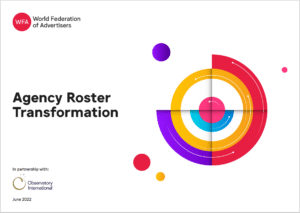A Guide to Agency Roster Transformation Success
Agency roster transformation is often needed by many organisations during times of widespread marketing industry change, however there is no template or one size fits all solution. To help organisations adapt, The Observatory International has compiled 5 key tips for ensuring that a roster model transformation process is a successful one.
Discovery
It is vital to engage stakeholders across the organisation to undertake a discovery process to unearth all needs and requirements, both current and future. This includes personnel from all key markets and business units such as any specialists in technology, data & insights, supply chain, product development and decision-makers across creative, media and PR. Attaining stakeholder input and cross-organisational buy-in is vital to a successful transformation roll-out.
An effective discovery process needs to offer a platform for stakeholders to have their say openly. Interviews, surveys and a review of current processes all help to create a complete picture of what is working and what needs to change. Contracting a third-party to run this process often helps to reduce biases and remove any peer pressure/internal politics, thus giving a truer picture of the business.
As well as marketing’s requirements, it is also important to engage procurement at an early stage to ensure transparency around the commercial factors that may influence the model. While 87% of survey respondents said that marketing took the lead on agency roster organisation and modelling, over 65% said that procurement was nevertheless involved.
The Model
The agency model should complement the organisation’s own structure and strategy and be set up to help drive forward the business ambitions of the company. Analysis of the discovery findings will highlight the direction of the vision.
As business requirements change, so too should the model. We are seeing a number of current trends being driven by businesses willing to transform their operations:
The rise of ‘Inside-out’ approaches
An increasing focus on data-driven digital communication has led to a new approach emerging with digital-first content creation at the heart of the model set-up. Client example: Braun – Media Monks
Re-convergence of media and creative
The need for greater agility, scale and speed to market is highlighting the unsuitability of a separated media and creative process for some brands.
Client example: Mercedes – Omnicom
Right-housing
The desire to have tighter control and flexibility is resulting in more companies bringing resource in-house. Often this is still agency resource but implanted into the client’s business. Furthermore, agency redundancies during the pandemic have widened the talent pool and delivery potential for in-house offerings.
Populating the Model
Identify the types of agencies that can best populate your model and enhance any skillsets you already have in place. Look for agencies who are highly collaborative in nature and can be flexible as your business requirements evolve. Also consider what capabilities you already have in-house or may wish to in-house as part of the transformation process.
Key considerations when selecting an agency:
- Make sure you have a resource which has an up to date, detailed knowledge of the agency landscape, not just a file with agency credentials
- Look for agencies who will challenge you in a constructive way
- Seek evidence of the agency working collaboratively with both clients and other agencies
- Awards – while some agencies don’t enter awards as a matter of choice, awards can still act as a good indicator. Ignore the vanity awards however and focus on those that reward effectiveness
- Understand the agency’s POV – have someone on hand – either internally or via a third party – who has intimate knowledge of how agencies work
- Be an attractive client – agencies are increasingly becoming more selective about which clients they work with, so ensure that you demonstrate your own qualities in collaboration, fairness and positive client behaviours – especially in a pitch scenario
- Recognise the agency’s potential to contribute to your business with great work and be prepared to pay for it. Without outstanding work which connects to the consumer, your media investments are wasted
- Ensure that the agency’s DEI and sustainability accreditations and ambitions match your expectations (and that yours match theirs also)
There is a growing focus on DEI and sustainability within the industry and we are seeing signs that agencies are now prepared to turn down work with brands and other industry partners if they aren’t committed to making societal and environmental changes.
Clients, too, are recognising that the structure of their rosters does have a significant impact on sustainability due to the duplication of effort through legacy processes. Some have begun asking their agencies to sign sustainability codes of conduct and to ensure that people from diverse backgrounds are included at all stages of the communications development process.
Measurement
All agency relationships should be monitored and evaluated on a regular basis, and this is even more important when a new roster is put in place.
A vital step to ensuring that your agency roster relationships remain positive and geared for success is the implementation of a consistent performance measurement process. Annual evaluations alongside quarterly business reviews are a recommended timeline, and these are in addition to individual project/campaign reviews. The frequency of the evaluations should be discussed when onboarding each agency partner and reflect the volume of investment. It is recommended that evaluations are done for each active market and then collated to give a global picture.
Having open, two-way dialogue as part of an ongoing evaluation approach allows for regular relationship monitoring and for the early identification of any problems. Without this, minor problems and hurdles can go unchecked and develop into bigger issues, which could explain why there is a growing lack of client satisfaction in their agency rosters.
Assistance with the Process
Where possible, involve a third-party consultancy to help you identify and develop the agency model. Their objectivity will help to give a truer overview of the business without bias and any politics, plus their management of the process reduces resource requirements on internal personnel.
Furthermore, utilising a specialist resource to help identify the best agencies to populate the model (once it has been designed) proves helpful for many.
Don’t be afraid to reach out to your peer network as well for guidance and advice. Most marketers will have undergone some form of agency model transformation and so can provide personal insights
To find out how we can help you with your marketing agency roster transformation take a look at methodology and approach here, or please contact us
(excerpt from WFA Roster Transformation report)
















